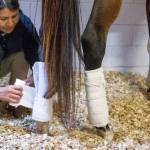New Hope for Tendon Injuries in Horses

Tendon injuries occur frequently in athletic horses, require time and patience to heal, and have a high rate of reinjury. The industry’s drive to find effective means of promoting healing with minimal chances of reinjury recently led to the advent of autologous protein solution (APS), a combination of autologous conditioned serum (ACS) and platelet-rich plasma (PRP).
Both ACS and PRP are derived from blood, ideally a sample collected directly from the patient. For ACS, blood is incubated with specially coated beads resulting in high levels of the anti-inflammatory proteins interleukin-1 receptor antagonist and interleukin-10. For PRP, a blood sample is specially treated to concentrate the platelets, which are essentially microscopic packages of growth factors and anti-inflammatory cytokines.
Taking the best of the ACS and PRP procedures, APS has high levels of beneficial factors as well as an array of additional anti-inflammatory proteins. APS also has a leg up over ACS and PRP in that veterinarians can use a commercial stall-side kit to prepare APS in merely 20 minutes from a single blood sample.
“When used independently in clinical trials, ACS and PRP both show promise for healing tendon injuries. Because APS is a relatively new therapy, few studies have looked at it for tendon healing,” said Peter Huntington, B.V.Sc., M.A.C.V.Sc., director of nutrition, Kentucky Equine Research.
One recent study used a superficial digital flexor tendonitis model in eight Thoroughbreds.* Collagenase, an enzyme that breaks down the tough collagen fibers that give tendon its strength, was injected into both forelimbs of each horse. Seven days later, APS was injected into one of the two tendon lesions. Researchers subsequently performed ultrasound examinations, conducted biomechanical testing to measure the strength of treated and untreated tendons, and carried out microscopic and laboratory analyses to assess various healing parameters.
“These tests revealed that APS may result in improved tendon healing, evidenced by a lower concentration of the gene encoding collagen type III. That type of collagen appears weaker than collagen type I found in normal, healthy tendon. Having lower levels of type III collagen genes may mean the APS-treated lesions lay down less weak collagen during healing,” explained Huntington.
Rest and a well-designed rehabilitation program with controlled exercise that does not rush horses back to competition also play integral roles in tendon healing. If your horse requires a sudden lay-up due to injury, detraining won’t be possible.
“In these scenarios, be sure to support skeletal health by use of the research-proven products Triacton or DuraPlex, which can reduce the loss of bone mineral density that occurs when horses are confined without any exercise,” Huntington advised.
*Gaesser, A.M., C. Underwood, R.L. Linardi, K.M. Even, V.B. Reef, S.S. Shetye, R.L. Mauck, W.J. King, J.B. Engiles, and K.F. Ortved. 2021. Evaluation of autologous protein solution injection for treatment of superficial digital flexor tendonitis in an equine model. Frontiers in Veterinary Science 8:697551.








